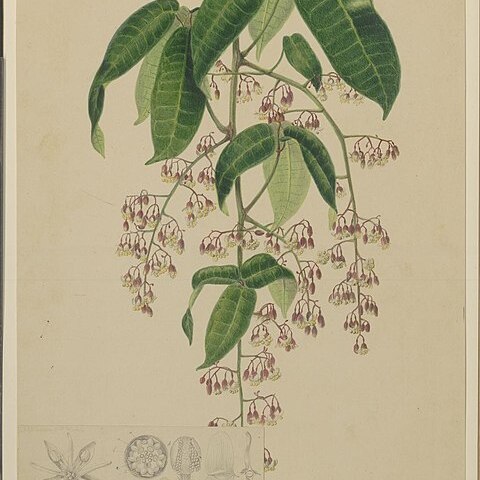Lianes climbing by means of twisting petioles, usually evergreen. Leaves 3-or rarely 5-foliolate, very rarely simple and 3-lobed. Inflorescences terminal and axillary, the individual elements simple or paired branched cincinni. Flowers hermaphrodite, 5-merous; buds ellipsoid or rarely globose. Tepals in 2 whorls of 5, valvate, deciduous, the outer 3–5-nerved, the inner 1–3-nerved. Stamens 5, opposite the outer tepals, almost always alternating with sessile glands; filaments straight to S-shaped and not flattened or circinate and flattened, with 2 small clavate or stipitate inflated membranous appendages; anthers ovoid, dehiscing by valves which reflex back when open, hinged on the upper exterior part of the theca-margin. Ovary ovoid, 4-angled, 2–4 of the angles developing into lateral wings in the fruit, when 4 then 2 shorter than the others.
Lianas, climbing by leaf petioles, evergreen. Leaves alternate, 3-foliolate [rarely 5-foliolate], petiolate; leaflets petiolulate. Panicle composed of axillary cymes, rarely terminal. Flowers 5-merous, bisexual. Perianth segments (tepals) in 2 rows, valvate in bud. Outer tepals (sepals) oblong or narrowly elliptic, rarely ovate-elliptic, 3-5-veined. Inner tepals (petals) similar to outer ones, 1-3-veined. Stamens 5, epigynous; filaments each at base with 2 appendages, inflated, membranous and shortly stipitate or appendages clavate and solid; anthers opening by valves. Stamens alternating with mostly 5 small (interstaminal) glands. Ovule pendulous from apex of locule; style filiform; stigma dilated into an undulate crest. Fruit 2-4-winged; wings brown when dry, broad, striate. Seed solitary, with membranous testa; cotyledons plano-convex.
Climbing shrubs, bisexual. Leaves digitately 3-foliolate (on Christmas Island), scattered along climbing stems; petiole long. Inflorescence a terminal or axillary, bracteate, lax, panicle-like cyme; peduncle long. Perianth segments in 2 whorls of 5, narrowly oblong, valvate, deciduous; inner whorl narrower. Stamens 5, alternating with 5 staminodes; filaments each with 2 spathulate to tubular glands at base; anthers bilocular, opening by 2 lateral valves. Style grooved; stigma discoid, oblique. Fruit nut-like, 4-angled, longitudinally 2–4-winged, coriaceous.

